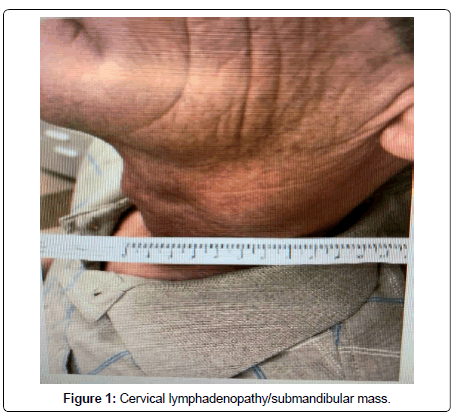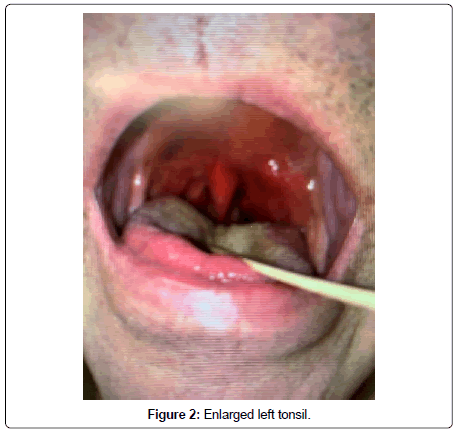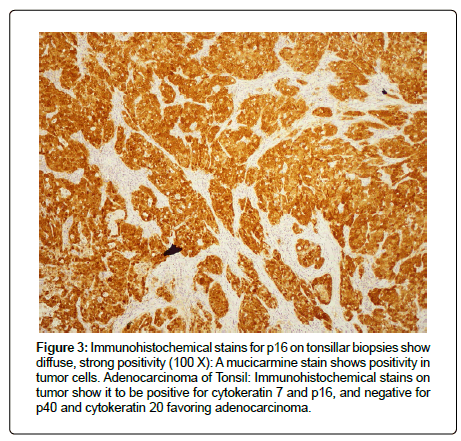Case Report, Clin Oncol Case Rep Vol: 5 Issue: 2
Human Papillomavirus Induced Adenocarcinoma of Tonsil: A Rare Entity
Ashish Sethi1*, John Sundermann2, and Pathe Neeta3
1Department of Oncology, Allegheny Health Network, Pittsburgh, Pittsburgh, USA
2Department of Pathology, Butler Health System, Butler, USA
3Department of Hematology and Oncology, Allegheny Health Network, Pittsburgh, Pittsburgh, USA
*Corresponding Author:
Ashish Sethi
Allegheny Health Network-Pittsburgh,
T320 E North Ave Suite 560, Pittsburgh, PA 15212, USA
E-mail: sethiashish63@gmail.com
Received: January 16, 2022, Manuscript No: M-51793;
Editor Assigned: January 25, 2022, PreQC No: P-51793;
Reviewed: February 21, 2022, QC No: Q-51793;
Revised: February 24, 2022, Manuscript No: R-51793;
Published: February 28, 2022, DOI: 10.4172/cocr.5(2).215
Citation: Sethi A, Sundermann J, Neeta P (2022) Human Papillomavirus Induced Adenocarcinoma of Tonsil: A Rare Entity. Clin Oncol Case Rep 5:2.
Abstract
Oropharyngeal carcinoma or tonsil cancers are mainly squamous cell cancers. Smoking, alcohol consumption and Human Papilloma Virus (HPV) infection are leading causative factors Oropharyngeal Squamous Cell Carcinoma (OPSCC). Locally advanced head and neck cancers are usually treated with combination of surgery and chemoradiation. We report a case of a 60 year old caucasian man with HPV induced primary adeoncarcinoma of tonsil and its clinical course.
Keywords: Adenocarcinoma; Human papilloma virus; Oropharyngeal cancer; Tonsil cancer; Keynote 040; Checkmate 141 trials; p16
Introduction
Tonsillar carcinoma is the second most common malignancy of the head and neck after laryngeal cancer [1]. Majority of tonsil cancer or oropharyngeal malignancy is Squamous Cell Carcinoma (SCC). Smoking and alcohol usage are commonly associated with tonsil cancer. Also, there has been a rise in the number of cases of tonsil cancer occurring secondary to the HPV infection. HPV 16 subtype has the greatest association with oropharyngeal cancers [2]. Diffuse pattern of p16 immunostaining is considered a highly sensitive marker for the identification of HPV type cancers [3]. We report a rare case of a 56 year old caucasian man presenting with HPV induced primary adeoncarcinoma of tonsil and its clinical course which is rarely documented in the medical literature.
Case Presentation
A 60-year-old Caucasian male presented with complaints of neck swelling and dysphagia of two months duration [Figure 1]. Patient was a former chronic smoker for 25 years and consumed alcohol occasionally. Patient had a good overall performance status at the time of initial presentation. Left cervical lymphadenopathy and enlarged left tonsil were positive findings on physical examination [Figure 1, Figure 2]. Computed tomography (CT) of neck with contrast showed left cervical lymphadenopathy in continuity with the tonsillar mass. Tonsillar mass was adjacent to internal carotid artery, encroaching the carotid sheath. Patient was not a surgical candidate based on CT findings. Tumor size measured 1.5 cm × 1.1 cm. Endoscopy and colonoscopy performed were inconclusive for malignancy. Initial Positron Emission Tomography (PET) scan illustrated left tonsillar mass of Standardized Uptake Values (SUVs) of 14.2, retropharyngeal node of SUV 7.2, left cervical nodal mass with right sided adenopathy which was consistent with malignancy. No other features of malignancy was seen on PET scan below the neck. The histopathological biopsy analysis of the left tonsillar fossa revealed poorly differentiated adenocarcinoma which was positive for p16, suggestive of tumor being HPV-related [Figure 3]. Biopsy slides were reviewed by three different pathologists to confirm the diagnosis of adenocarcinoma. The patient’s demographics, tumor characteristics, and the treatment details are illustrated below [Table 1].
| Characteristic | Case |
|---|---|
| Age | 60 |
| Gender | Male |
| Race | Caucasian |
| Smoking | Yes |
| Alcohol | Occasional (Socially) |
| Tumor grade | T1, N3, M0 |
| Tumor stage | III |
| Treatment plan | Induction chemotherapy with Cisplatin+Docetaxel+fluorouracil every 21 days followed by carboplatin with concurrent radiation |
Table 1: Patient demographics and initial management.

Figure 1: Cervical lymphadenopathy/submandibular mass.

Figure 2: Enlarged left tonsil.

Figure 3: Immunohistochemical stains for p16 on tonsillar biopsies show diffuse, strong positivity (100 X): A mucicarmine stain shows positivity in tumor cells. Adenocarcinoma of Tonsil: Immunohistochemical stains on tumor show it to be positive for cytokeratin 7 and p16, and negative for p40 and cytokeratin 20 favoring adenocarcinoma.
Adenocarcinoma of Tonsil: Immunohistochemical stains on tumor show it to be positive for cytokeratin 7 and p16, and negative for p40 and cytokeratin 20 favoring Adenocarcinoma.
After completing six cycles of carboplatin with concurrent radiation, three months later patient's disease progressed with PET scan revealing increased hypermetabolic activity of the known palatine malignancy, new and worsening bilateral cervical lymphadenopathy, pulmonary metastases, thoracic lymphadenopathy, and osseous metastatic disease. Later, biopsy performed on left cervical lymph node after disease progression also revealed metastatic poorly differentiated adenocarcinoma positive for p16 protein. Next generation sequencing (NGS) from the cervical lymph node biopsy was inconclusive for targeted therapy. Palliative treatment with carboplatin, 5-fluorouracil and pembrolizumab every twenty one days was further planned and has currently completed one cycle at the time of writing this case report.
Discussion
Lump in neck, otalgia, dysphagia hoarseness, persistent sore throat are frequently associated complaints in patient with tonsil cancer. However, clinical presentation varies with many patients remaining asymptomatic at the time of diagnosis. Not all cases of primary tonsil cancer presents with a visible lesion and tumors may be hidden in the tonsil crypts [4].
HPV-positive patients are predominantly seen in younger population group and those who use less alcohol and tobacco. As a group, they respond favourably to radiotherapy or surgery when compared to HPV-negative cancers in terms of improved locoregional tumour control, disease-specific survival, and Overall Survival (OS) [5-8] .Prognosis of HPV positive tonsil cancer showed a 5-year OS of 71% compared to 46% in HPV negative disease [9]. Unfortunately, up to 66% of patients with head and neck cancers are diagnosed at advanced stages- III and IV with about 10% of patients presenting as distant metastases [10]. Carcinoma of tonsil accounts for 10% of all head and neck cancers and local spread or neck node involvement are the usual mode of metastasis. Locally advanced oropharyngeal cancer or staged III and IV have high chances of recurrence and has poor prognosis. Meta-analysis of chemotherapy in head and neck cancer (MACH-NC) study included 19,248 patients which concluded that addition of concomitant chemoradiation decreased 5 -year mortality of 6.5% (hazard ratio for death, 0.83; 95% CI, 0.79 to 0.87; P<0.001) and loco regional failure rates [11,12]. Also, it concluded that adding induction chemotherapy did not improve OS, when compared with chemoradiation alone. Extensive elective neck dissection with adjuvant therapy is an alternative in treating T3 or T4 staged head and neck tumors [11,12].
Platinum drugs regimens vis cisplatin and carboplatin or sometimes Epidermal Growth Factor Receptor [EGFR] antibody cetuximab with concurrent radiation is the standard of care for patients with good performance status in locally advanced oropharyngeal cancers. Recent randomized trials have showed decreased survival with cetuximab and radiotherapy in patients with HPV positive oropharyngeal cancer compared to high dose cisplatin or carboplatin with radiation. Also, induction chemotherapy followed by chemoradiation in oropharyngeal cancers is mainly approached in those with the bulky disease or with high risk for loco regional relapse. However, many studies did not improve survival with upfront induction chemotherapy as compared with chemoradiotherapy alone., Immunotherapy has also influenced the treatment in metastatic head and neck cancers particularly squamous cell type. Keynote-040 and Checkmate 141 trials illustrated that programmed death-ligand 1 (PD-L1) expression (>50%) on tumor cells improved survival with anti-programmed cell death protein (PD-1) antibody treatment in such aggressive cancers [13,14].
Conclusion
Adenocarcinoma of tonsil is a rare entity. Its treatment approach is mainly extrapolated as per the guidelines followed for locally advanced head and neck cancer. Targeted therapies based on NGS may help in the treatment in the metastatic setting.
Refernces
-
Mankekar G (2002) Tonsillar carcinoma: A review. Ind J Otolaryngol Head Neck Surg 54: 67.
Google Scholar Cross Ref -
Kreimer AR, Clifford GM, Boyle P, Franceschi S (2005) Human papillomavirus types in head and neck squamous cell carcinomas worldwide: A systematic review. Cancer Epidemiol Biomarkers Prev 14: 467-475.
Google Scholar Cross Ref -
Lewis JS Jr, Thorstad WL (2010) P16 positive oropharyngeal squamous cell carcinoma:an entity with a favorable prognosis regardless of tumor HPV status. Am J Surg Pathol 34: 1088-1096.
Google Scholar Cross Ref -
Shoushtari A, Meeneghan M (2010) Intensity-modulated radiotherapy outcomes for oropharyngeal squamous cell carcinoma patients stratified by p16 status. Cancer 116: 2645-2654.
Google Scholar Cross Ref -
Fakhry C, Westra WH (2008) Improved survival of patients with human papillomavirus-positive head and neck squamous cell carcinoma in a prospective clinical trial. J Natl Cancer Inst 100: 261-269.
Google Scholar Cross Ref -
Lassen P, Eriksen JG (2009) Effect of HPV-associated p16INK4A expression on response to radiotherapy and survival in squamous cell carcinoma of the head and neck. J Clin Oncol 27: 1992-1998.
Google Scholar Cross Ref -
Licitra L, Perrone F (2006) High-risk human papillomavirus affects prognosis in patients with surgically treated oropharyngeal squamous cell carcinoma. J Clin Oncol 24: 5630-5636.
Google Scholar Cross Ref -
Charfi L, Jouffroy T (2008) Two types of squamous cell carcinoma of the palatine tonsil characterized by distinct etiology, molecular features and outcome. Cancer Lett 260: 72-78
Google Scholar Cross Ref -
Gooi Z, Agrawal N (2019) Tonsil Cancer. New Eng J Med 381: e8.
Google Scholar Cross Ref -
Cohen N, Fedewa S, Chen AY (2018) Epidemiology and demographics of the head and neck cancer population. Oral Maxillofac Surg Clin North Am. 30: 381-395.
Google Scholar Cross Ref -
Pignon JP, le Maître A, Maillard E, Bourhis J (2009) Meta-analysis of chemotherapy in head and neck cancer (MACH-NC): An update on 93 randomised trials and 17,346 patients. Radiother Oncol 92: 4-14.
Google Scholar Cross Ref -
Blanchard P, Landais C (2016) Meta-analysis of chemotherapy in head and neck cancer (MACH-NC): An update on 100 randomized trials and 19,248 patients, on behalf of MACH-NC group. Ann Oncol 27: vi328-vi350.
Google Scholar Cross Ref -
Cohen EEW, Soulières D (2019) Pembrolizumab versus methotrexate, docetaxel, or cetuximab for recurrent or metastatic head-and-neck squamous cell carcinoma (KEYNOTE-040): A randomised, open-label, phase 3 study. Lancet 393: 156-167.
Google Scholar Cross Ref -
Ferris RL, Blumenschein G (2016) Nivolumab for recurrent squamous-cell carcinoma of the head and neck. N Engl J Med 375: 1856-1867.
Google Scholar Cross Ref
 Spanish
Spanish  Chinese
Chinese  Russian
Russian  German
German  French
French  Japanese
Japanese  Portuguese
Portuguese  Hindi
Hindi 